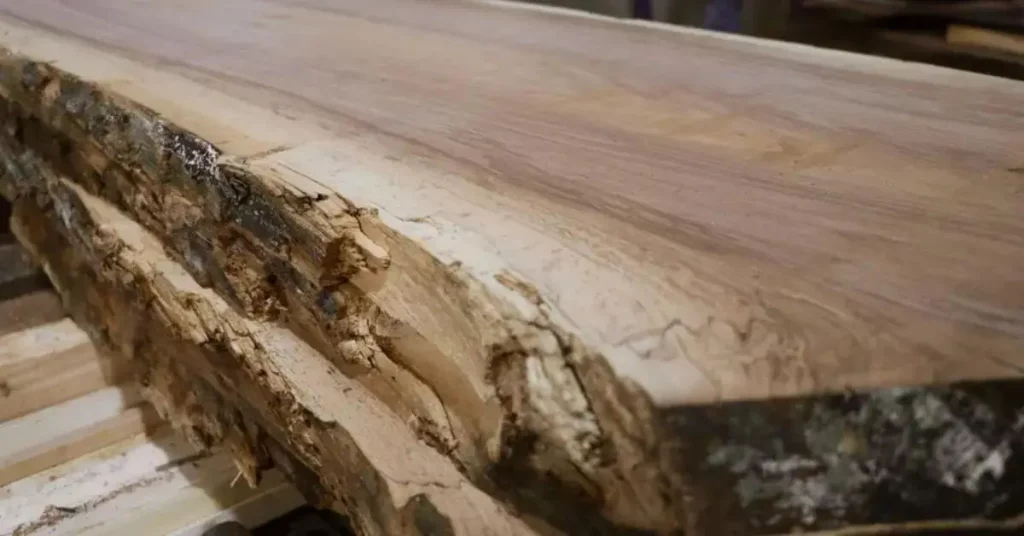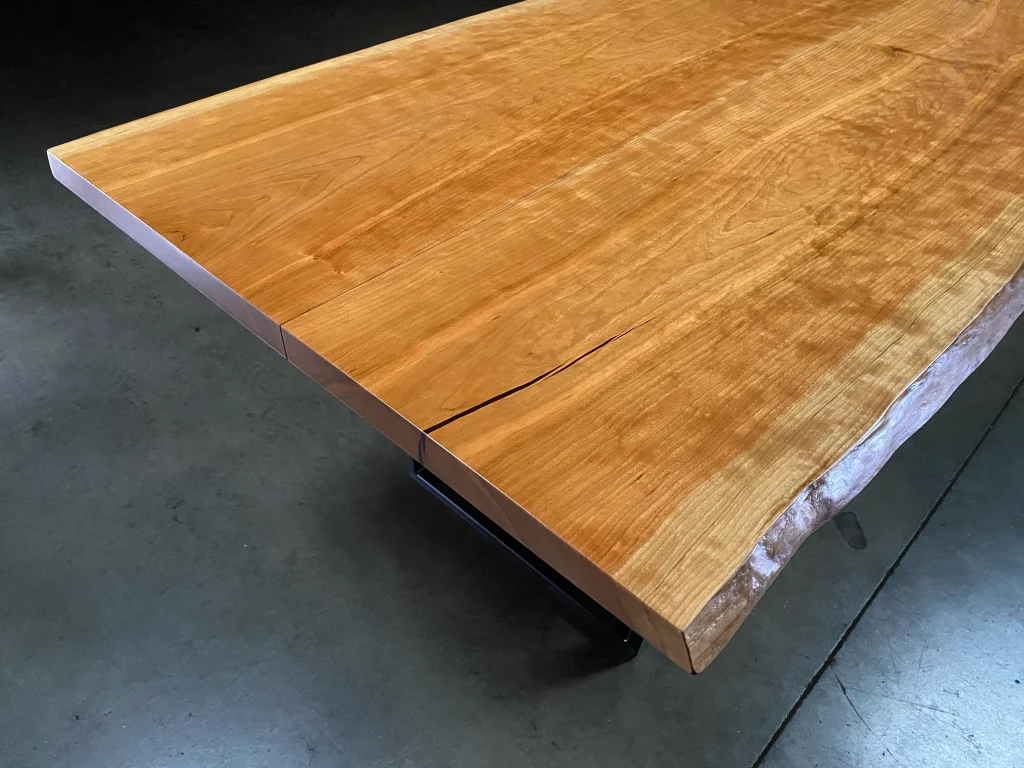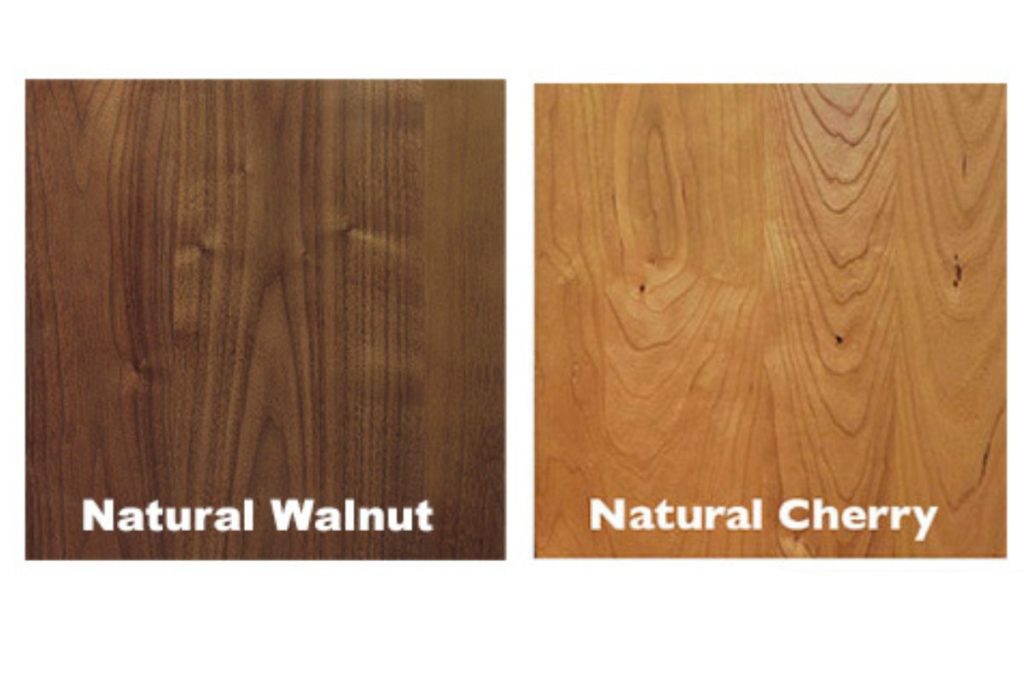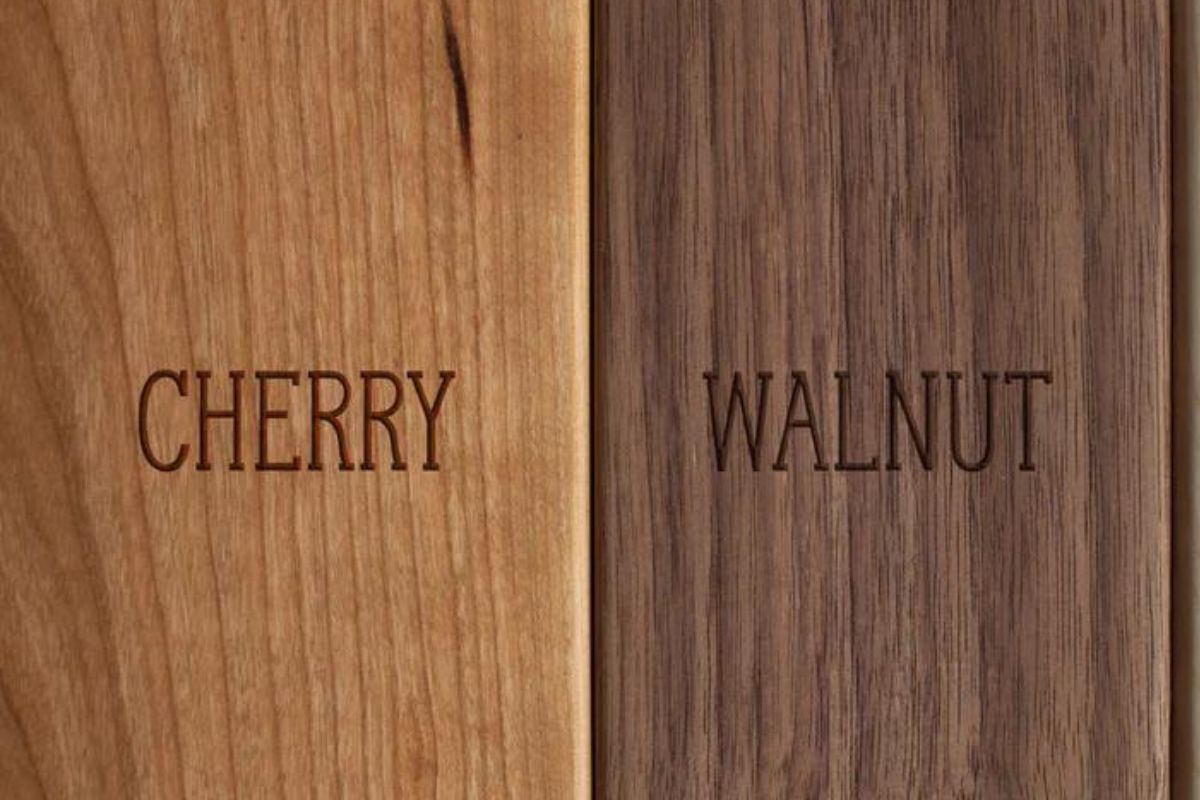Walnut vs. cherry wood, which should you use when it comes to furniture? Which one is best for home fixtures? To find out which wood is better for your home, we need to consider the characteristics of each. So without further ado, let’s dive into walnut wood and cherry wood characteristics.
Walnut Wood Characteristics

Walnut wood is from walnut trees. These are deciduous trees that are native to regions where there are temperate climates. There are many walnut species, and each one has striking characteristics, especially the wood’s color. European walnut species have a lighter hue compared to American walnut trees.
The walnut tree sapwood and heartwood are distinguishable and are from 5 to 10 centimeters. There are gray to red stripes on the wood surface, and the number and intensity of these stripes vary depending on where the tree grows and the age.
Walnut trees belong to the Juglan genus, but there are also non-juglan walnut species like the Brazilian Walnut, Queensland Walnut, African Walnut, New Guinea Walnut, and the Caribbean Walnut. Let’s highlight the four most popular walnut species and their uses: Black Walnut, English Walnut, Queensland Walnut, and the New Guinea Walnut.
Black Walnut (Juglans nigra)
Black walnut is the most popular walnut species in the United States. This is because of its unique working characteristics and beauty. Black walnut has a rich brown color which looks classy every which way. This wood is stable, resistant to shock, and is one of the strongest. You might say that black walnut makes a good wood for furniture-making and home construction.
- Location: black walnut is widely distributed in the Eastern United States
- Tree Size: 100 to 120 feet tall, 2 to 3 feet wide
- Average Dried Weight: 38 pounds per cubic feet
- Specific Gravity: .51, .61
- Janka Hardness: 1,010 pounds-feet
- Appearance: Black walnut has a light pale brown to dark brown heartwood with darker streaks. The color can range from grey to purple, while some may have a red cast. The sapwood is gray to pale yellow to white.
- Grain or Texture: there are patterns found on the grain, including curls, crotches, and burls. The black walnut grain is straight but may also be irregular. This has a medium texture and luster. The end grain varies from large to medium pores.
- Resistance to Rotting: this walnut species is durable against decay but may be susceptible to bugs and insect attacks, and burrowing.
- Workability: As long as the grain is straight, black walnut is easy to work with. Occasional planer tear outs are possible, especially when working with black walnut with irregular grains. These species handle glues, finishes, and stains well. You can use black walnut for steam bending projects.
- Presence of Odor: black walnut comes with a slight odor when it is worked.
- Availability: Black walnut is widely available and is known as a premium hardwood in domestic areas.
- Uses: this walnut species is commonly used to make furniture, cabinets, veneers, interior panels, and other small wooden projects
English Walnut (Juglans regia)
The English walnut is the most popular and most common walnut species in Europe. It is also the primary source of edible walnuts.
- Location: English walnut trees are from Eastern Europe and Western Asia
- Tree Size: 80 to 115 feet tall and 5 to 6 feet wide
- Average Dried Weight: 40 pounds per cubic feet
- Specific Gravity: .52, .64
- Janka Hardness: 1,220 pounds-feet
- Appearance: English walnut heartwood is light brown to dark chocolate brown and has darker stripes. This wood can have varying colors from gray, red, to purple. It has white sapwood. There are also unique grain patterns on the wood, such as burls, curls, and crotches.
- Grain or Texture: this walnut species has a straight grain but may sometimes have irregular grains. This has a medium texture and luster. The end grain has semi to very diffused pores.
- Resistance to Rotting: English walnut is moderately durable from rotting but is easily affected by burrowing insects.
- Workability: English walnut is easy to work with as long as the wood has a straight grain. You may encounter planer tear outs when you’re using walnut wood with irregular grains. This species can handle glues, stains, and finishes.
- Presence of Odor: this walnut species has a slight odor when it is worked.
- Availability: This walnut species is the most expensive and, thus, primarily available in veneers.
- Uses: English walnut is commonly used as furniture, cabinets, interior panels, turning projects, veneers, and other small wooden projects.
Queensland Walnut (Endiandra palmerstonii)
The Queensland walnut looks similar to the Black walnut. One striking characteristic of Queensland walnut wood is that it has incredible electrical insulation capabilities. This is why it’s commonly used to build electrical enclosures in Australia.
- Location: Queensland walnut is native to Northern Queensland in Australia
- Tree Size: 120 to 140 feet tall and 4 to 6 feet wide
- Average Dried Weight: 43 pounds per cubic feet
- Specific Gravity: .53, .68
- Janka Hardness: 1,670 pounds-feet
- Appearance: the Queensland walnut has a pinkish to dark brown color with pink, gray, or black stripes. This species resembles the English walnut, while lighter Queensland walnuts look like Ovangkol wood.
- Grain or Texture: this walnut species have interlocked and wavy grains with a medium texture, moderate luster, and open pores.
- Resistance to Rotting: Queensland walnut is moderate to non-durable to rotting and is often affected by insects.
- Workability: This wood is hard to plane because of interlocked grains. The high silica content of this wood can make tool edges blunt. This stains well and accepts glues, and finishes with ease.
- Presence of Odor: Queensland walnut does not emit any odor.
- Availability: this walnut species is widespread in Queensland. It is not available in lumber form in the United States and is expensive when purchased from the U.S.
- Uses: Queensland walnut wood is excellent for making cabinets, floors, furniture, millwork, and veneers.
New Guinea Walnut (Dracontomelon mangiferum)
The New Guinea Walnut is not a genuine walnut, but its appearance may sometimes resemble natural walnut wood.
- Location: New Guinea walnut is native to Southeast Asia
- Tree Size: 100 to 120 feet tall and 5 to 7 feet wide
- Average Dried Weight: 39 pounds per cubic feet
- Specific Gravity: .50, .62
- Janka Hardness: 910 pounds-feet
- Appearance: New Guinea walnut has a light to medium brown color with a red, green, or gray cast. You may also notice dark brown to black stripes. The sapwood is pink to grey, that’s separate from the heartwood. You’ll also see broken ribbon stripes when the wood is quartersawn.
- Grain or Texture: this walnut species have interlocked and irregular grains and moderate to coarse texture, and fantastic luster.
- Resistance to Rotting: this wood is perishable from rotting and has very little resistance to insects.
- Workability: You can use hand and power tools to cut this wood. It may have interlocked grains, but these are not a problem during cutting.
- Presence of Odor: New Guinea walnut has no odor.
- Availability: this wood is available in veneer, and prices can be moderate because this is imported wood.
- Uses: New Guinea walnut is for making cabinets, furniture, veneer, and floors.
Cherry Wood Characteristics

Cherry wood is from cherry trees. These are deciduous hardwood trees with a fine and even grain with a reddish-brown to a yellow hue. The tree can grow up to 100 feet, but the average height of cherry trees is 80 feet, and a trunk of 24 inches in diameter.
Cherry trees have a long lifespan, up to 100 years. However, some cherry trees are felled before they reach this age because their trunks start to rot. There are many cherry wood species, and the most common ones are Sweet Cherry and Black Cherry. Let’s highlight the characteristics and uses of these two popular cherry species.
Sweet Cherry (Prunus avium)
Sweet Cherry is the counterpart to Black Cherry, which is naturally from North America. This wood is more colorful compared to Black Cherry and is also denser and much more robust than this species. The tree is smaller and thus, produces smaller lumber pieces.
- Location: Sweet cherry is common in Europe and Asia
- Tree Size: 32 to 65 feet tall and 1 to 2 feet wide
- Average Dried Weight: 39 pounds per cubic feet
- Specific Gravity: .48, .60
- Janka Hardness: 1,150 pounds-feet
- Appearance: Sweet cherry has a light pink-brown heartwood when the tree is initially cut. The wood becomes darker and will become dark gold brown, especially when exposed to direct sunlight. It has pale yellow sapwood.
- Grain or Texture: this cherry species has a fine to moderate texture grain. It has a straight and slightly wavy grain.
- Resistance to Rotting: this wood is moderately resistant to rotting and is susceptible to boring insects.
- Workability: this wood is easy to work with using hand and power tools. Staining is difficult because the wood becomes blotchy due to its closed grain. You need to apply gel stain or sealer to protect the wood. It works well with glues and finishes.
- Presence of Odor: Sweet cherry wood has no odor.
- Availability: this cherry species is available only in Europe and is primarily grown in orchards. Sweet cherry veneers are also standard, and pricing depends on your location. Expect to pay high for this wood if you’re located in the United States.
- Uses: Sweet cherry is mainly used for making furniture, cabinets, musical instruments, veneer, carvings, and floors. It is also famous for small turned projects.
Black Cherry (Prunus serotina)
Black Cherry has a reddish-brown patina as the wood ages. This is also common in other hardwoods like the yellow poplar tree. The presence of the patina is accelerated when the wood is exposed to sunlight. Black Cherry fruits are edible, but it is more widely used for their lumber.
- Location: this cherry species is widely available in Eastern North America
- Tree Size: 50 to 100 feet tall and 3 to 5 feet wide
- Average Dried Weight: 35 pounds per cubic feet
- Specific Gravity: 0.47, 0.56
- Janka Hardness: 950 pounds-feet
- Appearance: Black cherry trees have a light pink, brown heartwood when it is freshly cut. The sapwood is pale yellow.
- Grain or Texture: the grain is straight with some curly patterns. Comes with a fine and even grain texture and medium luster.
- Resistance to Rotting: this cherry wood species is resistant to rot but is not recommended for exterior usage.
- Workability: Black cherry is a choice among woodworkers, hobbyists, and builders because of its easy workability. It machines well too. However, it does not do well when stained because of its possible blotchy appearance. Like Sweet cherry wood, you must use a sealer or a stain to protect the wood.
- Presence of Odor: you will smell slightly distinct when working with Black cherry wood.
- Availability: Black cherry lumber and veneer are available in the middle to upper price ranges.
- Uses: Black cherry wood is helpful in making furniture, millwork, floors, veneers, turned projects, and decorative items.
Cherry Wood vs. Walnut Wood

Now that you have a clear idea of the characteristics of each kind of wood let’s compare them according to appearance, strength, workability, and their uses at home. We can decide which wood is best for home use from these qualities.
Wood Color
Cherry wood is known for its stunning red hues. This is why cherry wood furniture and home décor are so valued. Cherry also has this ability to grow darker as the wood ages and also after prolonged exposure to direct sunlight. Some people love this quality of cherry wood, while some are not too happy about it.
Meanwhile, walnut wood is the opposite. Walnut has an exotic dark tone, but the wood turns lighter as it ages or becomes more exposed to light. Again, this is a striking color change that is unwelcome to many.
These characteristics and color changes are part of owning and caring for cherry and walnut furniture pieces. By considering these factors, you can care for your lovely cherry and walnut pieces carefully and avoid drastic color changes, at least for a few more years.
Cherry wood color varies from species to species and depends on the wood’s age. The most common cherry wood color you’ll find ranges from light brown to reddish-brown. The cherry heartwood or the wood found at the center initially has a pale pink to brownish color.
After some time, the heartwood becomes rich red. Another thing to consider is the sapwood which retains a pale yellow throughout time. It’s best to compare cherry wood colors to find one that matches your tastes.
When it comes to walnut wood, you’ll have rich brown colors from light to dark hues. The walnut sapwood is a pale yellow to whitish, while the heartwood is light to chocolate brown. You’ll also notice very dark streaks on the surface. These marks are a favorite among furniture collectors, and they use a dark stain to enhance these.
Essential points in cherry and walnut color changes
Cherry darkens over time while walnut wood turns lighter. These changes happen quicker when your wooden furniture is exposed to direct sunlight. To keep these from happening early, consider the best position where you will place your cherry or walnut furniture.
These must be placed away from direct sunlight. An open window or doorway can let sunlight in, so keep your furniture away from these areas. Also, the changes can be accentuated by exposure to heat and increased humidity. Keeping your furniture in a room with average moisture and temperatures would be best.
The color changes will eventually happen, and these should be as even as possible. Uneven color changes can affect the overall quality and beauty of your cherry and walnut furniture.
Wood Grain
The wood grain in cherry wood is simple, refined, and smooth. This wood has a closed and uniform pattern. Cherry wood is luxurious and sophisticated due to its soft and delicate texture.
You may also notice some minor imperfections that interrupt the flow of the grain. There are pitch flecks, mineral deposits, and random black spots or gum pockets. The marks are due to worm trackings, while mineral deposits are sap pockets. The black dots are also places where sap was stored. These minor imperfections in cherry wood contribute to its overall impressive look.
The walnut grain is straight and delicate but with a medium texture. You’ll also find some irregularities along the grain, like knots, curls, and waves. Just like cherry wood, these imperfections add to the overall quality of walnut wood.
Strength
Cherry is a softer kind of hardwood but still a strong hardwood. It is durable and strong, which is why it’s famous as indoor home furniture. Softer hardwoods mean that you must be more careful when handling this wood as this can easily show dents and marks. Cherry has a slightly less Janka Hardness test result than walnut at 950. Walnut wood has 1010.
Workability
Many woodworkers, furniture makers, and hobbyists prefer walnut to any wood because it’s easy to carve and turn. This wood is also effortless to bend using steam.
Walnut wood also accepts glues very well. Expect to use your hand and power tools easily when working with walnut. You can also attach screws and nails as this wood also handles these very well.
However, the exotic dark hues of walnut wood are not suitable for paint. You may need several paint layers before completely covering this wood. But most woodworkers prefer to stain walnut wood instead of painting them to highlight its lovely grain and color. These fantastic qualities make this wood the favorite for making office furniture.
When it comes to working cherry wood, this wood is easier because of its straight grain. It is mainly used as wood furniture and for making intricate carvings and projects. Cherry is easy to cut, and thus, you’ll find cherry furniture in various shapes and forms.
Cherry wood dries fast after staining. It is also excellent for steam bending, and it retains its strength even when it has been bent. You can attach nails or screws well on cherry wood. You can use rich stains to highlight cherry’s lovely grains. Almost any natural finish will work on cherry wood.
Cost
Walnut is more expensive compared to cherry wood; this is because walnut trees are not as readily available. Also, walnut trees don’t grow tall and thus, won’t produce a lot of wood compared to other hardwoods. Walnut woods are considered high-end wood no matter where you purchase them.
Meanwhile, cherry wood is more affordable and budget-friendly than walnut, as cherry trees are readily available in most areas.
Home Uses
Because of the beauty of walnut and cherry wood, both are used to make exquisite furniture. You’ll find walnut and cherry cabinets, beds, bed boards, shelves, chairs, dining tables, and coffee tables. Walnut wood furniture is often in antique shops and furniture stores and is the most expensive in the collection.
Aside from furniture, walnut and cherry wood are also popular as musical instruments as these can be bent using steam. You’ll find guitars, violins, guitars, fiddles, and percussion instruments made of walnut or cherry wood.
Both walnut and cherry woods are popular as home accents, veneers, and decorative items. There’s no end to their uses! But along with having walnut and cherry furniture and decorative objects at home, you must always consider wood color changes due to exposure to sunlight.
Avoid sunlight, direct heat, extreme temperatures, and humidity at all costs, and you can effectively preserve walnut and cherry pieces for a long time.
Final Words
Both walnut and cherry wood are great for home use. Because of these woods’ excellent properties such as color, wood grain texture, strength, and workability, these are more preferred than other hardwoods and softwoods.
The main concern for selecting these fine-quality woods is their prices. Walnut is very expensive; thus, many workers and hobbyists turn to cherry wood. This is why walnut furniture is more costly and elegant than cherry furniture pieces.

Leave a Reply